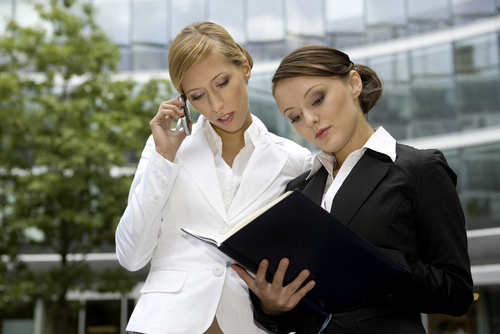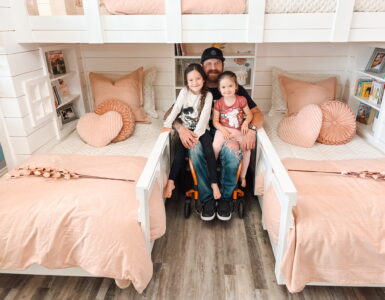We asked etiquette expert Ellen Reddick to narrow it down to the five most common mistakes people make while traveling.
1. Tipping Etiquette
TIPPING AT AIRPORTS AND TRAIN STATIONS
Upon arriving at or leaving from the airport or train station, tip the standard porter rate of $1 per bag; more if your luggage is very heavy. Typically, a $1 tip for hailing a taxi is appropriate for doormen. However, you may want to tip more for special services, such as carrying your bags.
HOTEL TIPPING ETIQUETTE
When you arrive at your hotel after a long flight, first things first: Tip the taxi or limo driver. Ten to 15 percent of your total fare is usually expected. If you drive your own car, give the valet parking attendant $1 to $2. If you take a shuttle van or bus, tip the driver $2 per person.
The bellman, who will be more than happy to assist you with your bags and the door, should receive $1 to $2 per bag. Tip when he shows you to your room and again if he assists you upon checkout. Tip more if he provides any additional service. The concierge, who can get you anything from dinner reservations to hard-to-come-by theatre tickets, deserves $5 to $10 for such feats. You may tip at the time of service or at the end of the trip. To ensure good service throughout your stay, add a $20 tip to the bill.
Add 15 percent of the bill to a room service charge, unless a gratuity is already added, then add no additional tip or simply $1. If you requested something delivered to your room such as a hairdryer or iron, tip $1 per item received. Typically, the maid deserves a $2 tip each day, as well.
TOUR TIPPING ETIQUETTE
If you’re taking a tour and a tip is not automatically included, tip a local guide $1 per person for a half-day tour, $2 for full-day tour. Tip a private guide more.
If you are on a multi-day tour with a tour manager – someone who travels with the group for several days and is essentially in charge – tour operators suggest anywhere from $3-8 per person per day. Don’t forget the bus driver either – $2 per person per day.
CRUISE TIPPING ETIQUETTE
When on a cruise, tip according to your comfort level and only on the last evening of your cruise. As a general rule, dining room waiters receive $3.50 per person/per day whereas the dining room assistant waiter should receive $2.00 per person/per day, the dining room maitre’d $3.50 per person/per day and the dining room manager $1.50 per person/per day.
The room steward, for all his efforts, receives $3.50 per person/per day. Other personnel, such as bar waiters, bellboys and deck stewards may be tipped as service is rendered.
RESTAURANT TIPPING ETIQUETTE
Although excellent service calls for 20 percent of the total bill, most U.S. restaurants accept 15 percent as the standard tip. In restaurants where you sit at the bar or the waiter is a small part of the meal (cafes or pubs), 10 percent is also acceptable. The bar tenders, themselves, generally receive between 15 and 20% when you sit at the bar. If the food or service is unsatisfactory, speak to the manager – don’t walk out without tipping. And pay attention to lunch and dinner bills in Europe and Asia, as some restaurants tack on an additional 15 percent (usually listed on the menu or check as a “service charge”) and do not expect tips.
At fancy restaurants, tip the maitre d’ between $5 and $10 if he gets you a table – more when the restaurant is full and you have no reservations. Tip $1 when you check your coat, and another $.50 to $1 for restroom attendants. For personal service from the wine steward, opt for 10 percent of the wine bill.
This tipping etiquette will hopefully give you a general idea of the standard tipping rate for different stops along your journey. You are always welcome to tip more when the service is excellent, and when you do, you are sure to see the red carpet treatment all the way. Enjoy your vacation, and don’t forget to tip!
2. Elevator Etiquette
There are reasons for elevator etiquette rules. The reasons are so that we will become a better person and help those around us to have a better day and know that we are making the world a better place – one elevator ride at a time. Going up?
GOING ONE FLOOR?
If you are going up or down one floor, use the stairs! This rule should especially be observed during peak traffic times like morning and afternoon rush.
Exceptions:
1. When you have a cart, stroller or large packages
2. When the elevator is empty
3. If you are disabled or injured
CALLING & WAITING
• Re-pushing the call button
NEVER re-push the call button after someone has already pushed it. This indicates that you either do not understand how the button works, or you do not trust the person that has already pushed the button to do an adequate job of it.
• Wait for the door
If you arrive as a door is closing, regardless of how many people are in the car, DO NOT press the button. The people in the car are already prepared mentally for their trip and do not need to be interrupted. WAIT for the door to close completely before pressing the button. If you press the button by mistake, and a door stops closing, do not board unless asked. Politely apologize and wait for their car to leave.
• Ok to ask
If pressing the call button would require you to push through someone, it is acceptable to ask someone else to push the call button for you as long as they are not further away from it or unable to reach the button for you (i.e. coffee in their hands, etc.)
OVERSIZE PACKAGES
In any case where you are carrying or pushing a large package, you should wait for an empty elevator. If you are invited to board a loaded car, be sure all riders agree to the invitation and that it is not mere polity. If you are unsure, insist that you are willing to wait for the next empty car.
If you have a backpack, briefcase or purse hold it in front of you where you can see it and make it as unobtrusive as possible.
BOARDING
• Allow Them to Exit
While waiting to board, stand AWAY form the door opening. DO NOT board the car unless you are sure no one is getting off on your floor. If there is someone exiting, allow them to clear the door before attempting to board.
• Crowded Elevator
To determine whether you should board the car, determine if there is enough room for you and your buffer space. As a rule of thumb, there should be room for two people for every one that is attempting to board.
During high traffic times, you may find it necessary to board a car that is crowded. If there is not a verbal invitation to board, the passengers may welcome you by making room for you, consider that an invitation to board. If you are with someone else, do not assume that the invitation stands for all of you. It may be necessary to split up and agree to meet at your destination floor.
• Holding the Door
Holding the door for someone that is running toward the car is only appropriate when the car is empty or there is consensus among the passengers that it is ok to wait.
• Closing the Door
Closing the door using the door close button should be done only when it is clear that no one is trying to board the elevator or when there are other cars available to go in the same direction. It is improper to close the door on someone that is moving toward the elevator.
It is also acceptable to close the door when you are in a full elevator that stops at a floor for a passenger who indicates they would like to wait for the next car. Give them a chance to make their decision to board or not to board before closing the door.
• Blocking the Door
It is inappropriate to block an elevator door from the outside for any reason. Do not abuse the safety devices built in to the elevator door. Refrain from sticking feet, hands, umbrellas, briefcases or other items in front of a closing elevator door.
• Where to Stand
You should stand as close to a wall as possible. Consider your destination floor and stand near the back if you are going to a high floor. If you know you are getting off shortly, stand toward the front. If you choose to stand near the buttons, understand that you may have increased responsibility. Ask if you may push the button as people board.
ONCE THE DOOR IS CLOSED
Smile and acknowledge others as you board an elevator. It is acceptable to continue a conversation that was started before boarding as long as it is not clearly irritating others in the car. Avoid lewd jokes and topics that could offend others. If you feel the other passengers are not enjoying your discussion STOP talking and continue when you have arrived at your destination floor.
Never use a cell phone or SMS device while in an elevator. It is the height of rudeness.
When talking on an elevator be considerate, talk softly and do not assume that everyone in the car cares about what you are saying.
If your personality dictates that you must start a conversation with complete strangers, say hello and start with light discussion about weather or current events. Avoid topics that may get cut off when one of you reaches their destination floor.
If passengers board while conversing, DO NOT think this is an invitation to join their conversation. Do not cut in unless you are invited to join the discussion.
Do not make fun of people or make comments when they get off the elevator. You never know if other passengers in the car know the person.
Singing, humming and whistling are generally discouraged.
If you are wearing headphones, they should be turned down to a level that cannot be heard by other passengers.
THE “MY FLOOR” RULE
In a crowded elevator, when there are others between you and the door, announce that the elevator has arrived at your floor and excuse yourself while making your way through the crowd. Pushing is discouraged.
GET OUT OF THE WAY
When standing between someone trying to exit and the door, do your best to move out of the way for them. Exit the elevator, allow them to leave and re-board.
Always assume there is a courteous way to behave in any given situation and then learn what that way is…..it is the little things in our everyday lives that bring quality to our world.
3. Airplane Etiquette
Air travel can be stressful. Tons of people crammed into a tiny space for hours on end…not my idea of fun — especially when people have differing views as to what is appropriate, what the rules of basic hygiene are, and how to behave amidst perfect strangers. Here are some basic rules of air travel to make sure you and your fellow passengers can get through a flight without losing your sanity. Don’t leave home without them (and print out a copy for the rest of the flight)!
THE PERSONAL BUBBLE
Do: Pretend there is a bubble extending from every plane passenger 9 inches into space. Respect that space!
Don’t: Recline your seat the second you get on board — wait until you are in the air and when you do, do it slowly so as not to knock the person behind you. Also, don’t try to read/look over your seat-mates shoulder. It violates the aforementioned bubble and they WILL notice. On the flip side, make sure you’re not showcasing your own personal documents.
FAMILIES
It can be so difficult traveling with young kids and many of us have been there. Some tips to help respect the rest of the flight:
Do: Park yourself near the back of the plane if possible. You’ll be close to the bathroom and a spot to get up and stretch or do whatever it is you and your little ones need to do.
Don’t: Allow your child to have free run of the plane. Sometimes screaming children can’t be helped. But what you can do is make sure they keep their arms/legs in their seats. Having your seat kicked or your face smacked as the child next to you has a tantrum can make a flight unbearable.
Never: Change a soiled diaper at your seat and place it in the seat pocket in front of you, leaving it for someone else to dispose of after you are gone.
CHATTY-CATHY
Do: Be polite. Here’s an easy way to avoid obnoxious conversation: “I’m sorry I’ve taken a sleep aid” + big sunglasses, usually does the trick.
Don’t: Be that person! If your conversation seems one way or you’re getting one word answers TAKE THE HINT. It’s nice to meet interesting people on a plane, but not everyone is looking to make new friends — they could be working, sleeping, or just not in the mood. Be respectful!
THE NOISE ISSUE
Do: Be aware of the noise you’re making — if you’re sitting next to a friend, whisper or use a hushed tone — people DO try to sleep or get work done on flights!
Don’t: Turn on your personal media without doing the volume test:
1) Find the volume you like.
2) Take headphones off.
3) If the music/movie is still audible, turn it down to the volume your seat-mates will like.
BODY ODOR
It may seem obvious, but if you travel frequently, chances are you’ve encountered those charming individuals who don’t adhere to the following rules:
Do: Shower! And please use deodorant or antiperspirant before climbing into an extremely small space with more than 50 people.
Don’t: Take your shoes off if you know you have smelly feet. Also, take it easy on cologne/perfume that day — people may not share your appreciation of the scent and some are allergic to the chemicals in perfume.
THE ARMREST WAR
The armrest war is an infamous airplane debacle. Here are (what I feel to be) reasonable rules of the armrest:
Do: Let the poor sucker who’s jammed in the middle seat have two.
Don’t: Shove or steal the armrest the second your seat-mate raises his/her arm, or violate the space of the person next to you if you should be the victor of the armrest battle.
AISLE ETIQUETTE
Don’t: Be aggressive when boarding/disembarking. It is not a race. Your seat is already assigned, and they’re pretty much all the same anyhow. There is no reason to push or shove people trying to stow or retrieve their luggage from overhead bins.
Do: Let the flight attendant know if you’ve just got to catch another flight/connection. We all know how painful it is to watch the minutes go by while people try to get their stuff in order and you’re already late. A flight attendant has the ability to move your seat up to begin with or help you get off first.
YOUR STUFF
Do: Keep your bags low and in front of you when getting on and off the plane to avoid knocking the people who are already seated. Also, consolidate your stuff BEFORE you get on the plane so other people can get to their seats and you don’t dump your things on the person sitting next to you.
Don’t: Put your suitcase into any old overhead bin. Make sure it’s the one next to your seat — otherwise the people who sit below the overhead bin you’ve randomly selected won’t have a place for their stuff.
THE CALL BUTTON
Do: Push the button if you have a good reason.
Don’t: Get button happy — the flight attendants have more passengers to deal with than just you, not to mention other duties on the flight than to cater to your every whim. It’s usually a good idea not to irritate the people that have the ability to make your flight comfortable or miserable.
THE BATHROOM
Do: Book an aisle seat if you know you MUST go to the bathroom every hour. It’s obnoxious to other people to have to wake up, move their stuff, and be climbed over.
Don’t: Make the person next to you climb over you should they need to get up. It’s rude. Get out of your seat and stand in the aisle so they can get out.
4. Traveling with Pets
ANYWHERE
• Always call ahead to make sure an establishment or place allows dogs.
• Only travel with a well-behaved dog that is friendly to people and especially children. If your dog is not comfortable around other people, you might consider taking your dog to obedience classes or hiring a professional trainer.
• Please keep your dog leashed. People that are afraid of dogs or even people with leashed dogs will greatly appreciate it. Plus most hotel owners, restaurant owners, store owners, and festival coordinators require your dog to be on leash.
• Always clean up after your dog. Pet stores sell pooper scooper bags. You can also buy sandwich bags from your local grocery store. They work quite well and are cheap!
FESTIVALS, OUTDOOR EVENTS
• Make sure your dog has relieved himself or herself before entering a festival or event area. The number one reason that most festival coordinators do not allow dogs is because some dogs go to the bathroom in areas where people might sit or on a vendor’s booth.
HOTEL LOBBY
• Unless it is obvious, ask the hotel clerk if dogs are allowed in the hotel lobby.
HOTEL ROOMS
• Never leave your dog alone in the hotel room. The number one reason hotel management does not allow dogs is because some people leave them in the room alone. Some dogs, no matter how well-trained, can cause damage, bark continuously or scare the housekeepers. Unless the hotel management allows it, please make sure your dog is never left alone in the room. We have even found a case where two dogs were stolen from a hotel room.
• While you are in the room with your dog, place the Do Not Disturb sign on the door or keep the dead bolt locked. Many housekeepers have been surprised or scared by dogs when entering a room.
• When your dog needs to go to the bathroom, take him or her away from the hotel rooms and the bushes located right next to the rooms. Try to find some dirt or bushes near the parking lot. Some hotels have a designated pet walk area.
RESTURANTS
• Most of the restaurants we have listed allow 1-2 dogs per table. If you have more dogs than this, you might want to ask the management if it is okay.
STORES
• Keep a close eye on your dog and make sure they do not go to the bathroom in the store. Store owners that allow dogs inside assume that responsible dog owners will be entering their store. Before entering a dog-friendly store, visit your local pet store first. They are by far the most forgiving. If your dog does not go to the bathroom there, then you are off to a great start! If your dog does make a mistake in any store, offer to clean it up.
5. Rudeness in General
Be aware of others and practicing common courtesies such as noise, saying thank you and understand what is expected of you. Pick up after yourself – in the rest room, the hotel room, the rental car, the hotel lobby.
Ellen Reddick is the co-founder of Impact Factory Utah and Elite Business Communications, Inc. Salt Lake City based companies specializing in training, consulting and coaching in business professionalism and communications.
Ellen is a well know Executive and Corporate Consultant who works with executives and corporations to help identify and assess developmental opportunities for both organizations and individuals. Her unique, practical and powerful strategies make her easy to talk to and her vast corporate background helps her coach high-potential individuals and those requiring new skills to enhance their leadership competencies. Her business experience is varied and extensive including Director for Fairchild Telecommunications International and the national Quality & Process Improvement Director for Lucent Technologies.
She is also a noted author of several business books and articles. Her books include The Art of Professionalism in Our Lives and The Complete Job Search Handbook. She currently writes a monthly column for The Enterprise Newspaper and participates in several business blogs.
Ellen can be reached at: (801) 581-0269 or www.impactfactoryutah.com.















Add comment